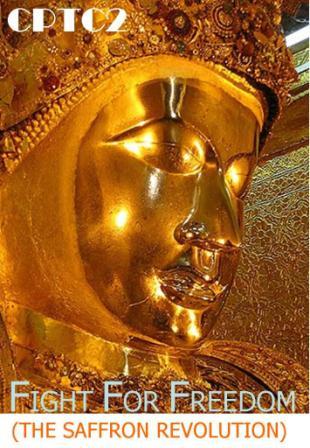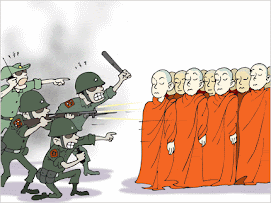3I.jpg)
3H.jpg)
3G.jpg)
3F.jpg)
3E.jpg)
3D.jpg)
3C.jpg)
3B.jpg)
3A.jpg)
Burma Protests: the Situation on October 03
Rangoon—Burma's military authorities have released 80 monks who were rounded up last week in the Rangoon crackdown, Reuters reported on Wednesday. One of the freed monks told the news agency that he and 79 monks were returned to their Mingle Yuma monastery in Rangoon. The monk says they were held at a government technical institute in northern Rangoon's Inseam Township, and subjected to verbal—but not physical—abuse during interrogations.
Who Wears the Butcher’s Apron Now?
Whenever killings and massacres have occurred in Burma’s turbulent political history, the names of those responsible are invariably linked with the epithet “butcher.”
At the time of the 1988 popular uprising, Sein Lwin became a household name after a massacre in Rangoon in which he was widely believed to have been involved.
Nineteen years later, Burma’s hard line junta led by Snr-Gen Than Shwe stands accused of responsibility for the bloodshed on the streets last week. Burma has another “butcher.”
Some Burma watchers believed that the regime’s number two man, Vice Snr-Gen Maung Aye, might not have agreed with the indiscriminate killings.
Burma analyst Win Min said that Lt-Gen Myint Swe, chief of the Bureau of Special Operation 5 and Military Affairs Security, and Brig-Gen Hla Htay Win, Chairman of the Rangoon Division Peace and Development Council, were also involved in the crackdown.
Analysts said that Myint Swe, former Rangoon Division Commander, wielded influence over Hla Htay Win, and was likely to have ordered him to carry out the crackdown on peaceful demonstrators.
There were reports that Hla Htay Win at first refused to obey the order and could face dismissal. But the government newspaper The New Light of Myanmar on Tuesday reported on a visit by the Rangoon regional commander to a government project, apparently countering rumors of a split.
Some dissidents in Rangoon also have conflicting reports on who was behind the orders to suppress the demonstrations by force.
Dissident groups speculated that Hla Htay Win could have been directly responsible for the death of a Japanese journalist, Kenji Nagai, who was shot on September 27 near Sule Pagoda, in central Rangoon.
Reliable sources said that the soldiers who opened fire into crowds of demonstrators in Rangoon were from Light Infantry Division 77, led by Brig-Gen Win Myint, who belongs to the Than Shwe camp.
Some exiled media had reported that tension had arisen between the LID 77 and LID 66 after LID troops refused to open fire on civilians and Buddhist monks.
Other hardliners suspected of involvement in the violent crackdown were Industry Minister Aung Thaung and Home Affairs Minister Maung Oo.
They are both executive members of the government-sponsored Union Solidarity and Development Association, whose patron is Than Shwe. USDA members took part in the thuggish attacks on the 88 Generation Students group and some members of the National League for Democracy when they held demonstrations in August.
In the aftermath of last week’s bloody events in Rangoon and elsewhere, the dissident community is looking for the man to take the title of “butcher” from Sein Lwin.
Brig-Gen Sein Lwin bloodstained record began with a crackdown on students demonstrating at Rangoon University on July 7, 1962. He served in Gen Ne Win’s 4th Burma Rifles and became Ne Win’s principal henchman in the coup of 1962.
Sein Lwin took charge as president during the 1988 uprising, but his reign lasted only 18 days before his government fell.
Rangoon—Burma's military authorities have released 80 monks who were rounded up last week in the Rangoon crackdown, Reuters reported on Wednesday. One of the freed monks told the news agency that he and 79 monks were returned to their Mingle Yuma monastery in Rangoon. The monk says they were held at a government technical institute in northern Rangoon's Inseam Township, and subjected to verbal—but not physical—abuse during interrogations.
Who Wears the Butcher’s Apron Now?
Whenever killings and massacres have occurred in Burma’s turbulent political history, the names of those responsible are invariably linked with the epithet “butcher.”
At the time of the 1988 popular uprising, Sein Lwin became a household name after a massacre in Rangoon in which he was widely believed to have been involved.
Nineteen years later, Burma’s hard line junta led by Snr-Gen Than Shwe stands accused of responsibility for the bloodshed on the streets last week. Burma has another “butcher.”
Some Burma watchers believed that the regime’s number two man, Vice Snr-Gen Maung Aye, might not have agreed with the indiscriminate killings.
Burma analyst Win Min said that Lt-Gen Myint Swe, chief of the Bureau of Special Operation 5 and Military Affairs Security, and Brig-Gen Hla Htay Win, Chairman of the Rangoon Division Peace and Development Council, were also involved in the crackdown.
Analysts said that Myint Swe, former Rangoon Division Commander, wielded influence over Hla Htay Win, and was likely to have ordered him to carry out the crackdown on peaceful demonstrators.
There were reports that Hla Htay Win at first refused to obey the order and could face dismissal. But the government newspaper The New Light of Myanmar on Tuesday reported on a visit by the Rangoon regional commander to a government project, apparently countering rumors of a split.
Some dissidents in Rangoon also have conflicting reports on who was behind the orders to suppress the demonstrations by force.
Dissident groups speculated that Hla Htay Win could have been directly responsible for the death of a Japanese journalist, Kenji Nagai, who was shot on September 27 near Sule Pagoda, in central Rangoon.
Reliable sources said that the soldiers who opened fire into crowds of demonstrators in Rangoon were from Light Infantry Division 77, led by Brig-Gen Win Myint, who belongs to the Than Shwe camp.
Some exiled media had reported that tension had arisen between the LID 77 and LID 66 after LID troops refused to open fire on civilians and Buddhist monks.
Other hardliners suspected of involvement in the violent crackdown were Industry Minister Aung Thaung and Home Affairs Minister Maung Oo.
They are both executive members of the government-sponsored Union Solidarity and Development Association, whose patron is Than Shwe. USDA members took part in the thuggish attacks on the 88 Generation Students group and some members of the National League for Democracy when they held demonstrations in August.
In the aftermath of last week’s bloody events in Rangoon and elsewhere, the dissident community is looking for the man to take the title of “butcher” from Sein Lwin.
Brig-Gen Sein Lwin bloodstained record began with a crackdown on students demonstrating at Rangoon University on July 7, 1962. He served in Gen Ne Win’s 4th Burma Rifles and became Ne Win’s principal henchman in the coup of 1962.
Sein Lwin took charge as president during the 1988 uprising, but his reign lasted only 18 days before his government fell.

3J.jpg)




























No comments:
Post a Comment